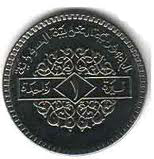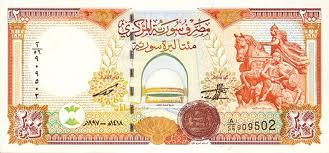|


The Syrian pound (Arabic: الليرة السورية al-līra as-sūriyya, French: livre syrienne) is the currency of Syria and is issued by the Central Bank of Syria. The pound is subdivided into 100 qirsh (Arabic: قرش plural: قروش, qorush, piastres in English or French), although coins in qirsh are no longer issued.
Before 1947, the word qirsh was spelled with the initial Arabic letter غ, after which the word began with ق. Until 1958, banknotes were issued with Arabic on the obverse and French on the reverse. After 1958, English has been used on the reverses, hence the three different names for this currency. Coins used both Arabic and French until Syrian independence, then only Arabic.
The standard abbreviation for the Syrian pound is SYP. On 5 December 2005, the selling rate quoted by the Commercial Bank of Syria was 58.4 SYP to the US dollar. A rate of about 50 pounds to one dollar has been usual in the early 2000s, but the exchange rate is subject to fluctuations. The pound is not a hard currency, and there are restrictions on its export.
History
During the period when Syria was a part of Ottoman empire -which lasted about 400 years- the Turkish lira was the currency. Following the fall of the Ottoman empire and the placing of Syria under a mandate (French Occupation), the Egyptian pound was used in the territories under French and British mandates, including Lebanon, Transjordan, and Palestine. Upon taking Lebanon and Syria under its separate mandate, the French government sought to replace the Egyptian currency and granted a commercial bank, the Banque de Syrie (a French affiliate of the Ottoman Bank), the authority to issue a currency for states under its new mandate.
The pound (or livre as it was then known) was introduced in 1919 and was pegged at a value of 20 French francs[citation needed]. As the political status of Lebanon evolved, the Banque de Syrie, which was to act as the official bank for Lebanon and Syria, was renamed the Banque de Syrie et du Grand-Liban (BSL). The BSL issued the Lebanese-Syrian currency for 15 years, starting in 1924. Two years before the expiration of the 15 year period, the BSL split the Lebanese-Syrian currency into two separate currencies that could still be used interchangeably in either state. In 1939, the bank was renamed the Banque de Syrie et du Liban.
In 1941, the peg to the French franc was replaced by a peg to the British pound of 8.83125 Syrian pounds = 1 British pound, as a consequence of the occupation of Syria by British and Free French forces. This rate was based on the pre-war conversion rate between the franc and sterling. In 1946, following devaluation of the franc, the Syrian pound was pegged once again to the franc at a rate of 1 pound = 54.35 francs. In 1947, the U.S. dollar was adopted as the peg for the Syrian currency, with 2.19148 pounds = 1 dollar, a rate which was maintained until 1961. The Lebanese and Syrian currencies split in 1948. From 1961, a series of official exchange rates were in operation, alongside a parallel, market rate which diverged dramatically from the official rate in the 1980s.
Coins
In 1921, cupro-nickel ½ qirsh coins were introduced, followed in 1926 by aluminium bronze 2 and 5 qirshan. In 1929, holed, nickel-brass 1 qirsh and silver 10, 25 and 50 qirsha were introduced. Nickel-brass ½ qirsh were introduced 1935, followed by zinc 1 qirsh and aluminium-bronze 2½ qirsh in 1940. During the Second World War, brass 1 qirsh and aluminium 2½ qirsh emergency coins were issued. These pieces were crudely produced and undated.
A new coinage was introduced between 1947 and 1948 in denominations of 2½, 5, 10, 25 and 50 qirsha and 1 pound, with the 2½, 5 and 10 qirush struck in cupro-nickel and the others in silver. Aluminium-bronze replaced cupro-nickel in 1960, with nickel replacing silver in 1968. In 1996, following high inflation, new coins were introduced in denominations of 1, 2, 5, 10 and 25 pounds, with the 25 pounds a bimetallic coin. In 2003 5, 10, and 25 pound coins were issued, with latent images.
Banknotes
In 1919, the Banque de Syrie introduced notes for 5, 25 and 50 qirsha, 1 and 5 livres. These were followed, in 1920, by notes for 1 qirsh and 10, 25, 50 and 100 livres. In 1925, the Banque de Syrie et du Grand-Liban began issuing notes and production of denominations below 25 qirsha ceased. Notes below 1 livre were not issued from 1930. In 1939, the issuing body again changed its name, to the Banque de Syrie et du Liban.
Between 1942 and 1944, the government introduced notes for 5, 10, 25 and 50 qirsha. In the early 1950s, undated notes were issued by the Institut d'Emission de Syrie in denominations of 1, 5, 10, 25, 50 and 100 livres, followed by notes dated 1955 for 10 and 25 livres. The Banque Centrale de Syrie took over paper money issuance in 1957, issuing the same denominations as the Institut d'Emission.
In 1958, the French language was removed from Syrian banknotes and replaced by English. Notes were issued for 1, 5, 10, 25, 50, 100 and 500 pounds. The 500 pounds note was only issued dated 1958 but was reintroduced in 1976. In 1997 and 1998, a new series of notes was introduced in denominations of 50, 100, 200, 500 and 1000 pounds, with the lower denominations replaced by coins. It is expected that the Central Bank of Syria will introduce banknotes of 2000 and 5000 pounds soon
2010 series
New 50, 100, 200 Pound.
Use of 10 Syrian pound coins in Norway
The shape of the 10 Syrian pound coin has been found to so resemble the 20 Norwegian krone coin that it can fool vending machines, coins-to-cash machines, arcade machines, and any other coin-operated, automated service machine in the country. While hardly similar to the naked eye, machines are unable to tell the coins apart due to an almost identical weight and size.
As of November 23, 2007, ten Syrian pounds converts to 1.07 Norwegian kroner, or about 0.20 United States dollar. 20 NOK, on the other hand, converts to 3.70 USD, almost 18.6 times the value of the Syrian coin. While not easy to find in Norway, the Syrian coins are still used in automated machines there with such frequency that Posten Norge, the Norwegian postal service, decided to close many of their coins-to-cash machines on February 18, 2006, with plans to develop a system able to differentiate between the two coins. In the summer of 2005, a Norwegian man was sentenced to 30 days, suspended, for having used Syrian coins in arcade machines in the municipality of Bærum.
The text on this page has been made available under the Creative Commons Attribution-ShareAlike License and Creative Commons Licenses
|
